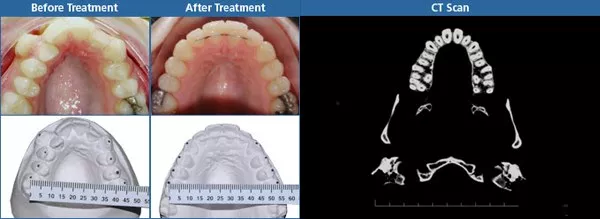Full Arch Development
Fewer Extractions and No RPEs
CT scans on Damon patients prove conclusively that the Damon System can provide lateral arch adaptation while keeping teeth perfectly centered in bone. This ability to achieve transverse arch development helps minimize the need for tooth extractions and invasive procedures such as rapid palatal expanders or surgery.
The face-driven treatment philosophy of the Damon System helps convert anterior crowding into the posterior adaptation of bone, muscle, and soft tissues because the lower forces do not overpower the lip musculature. In conventional treatment, higher forces are required to move teeth, which can overpower the facial musculature and push the anterior forward. But with the light forces of the Damon System, a lip-bumpering effect occurs whereby the orbicularis oris muscle prevents the incisors from dumping forward. As a result, teeth are allowed to follow the path of least resistance, sliding distally and laterally
This "power of the transverse" reflects early research conducted by Dr. Robert Ricketts that shows how significant arch length can be achieved by gaining lateral width. For example, a gain of 1 mm in cuspid width yields an increase of 1 mm in arch length. A gain of 4 mm in molar width yields an increase of 1 mm in arch length.
As the case to the right demonstrates, the Damon System achieved posterior arch width without the use of a rapid palatal expander or surgery. The plaster models indicate the patient gained 9 mm of posterior arch width, while the posttreatment CT image shows transverse arch development with normal alveolar bone on the lingual and buccal surfaces, proving that arch development occurred without blowing teeth out of cortical bone.
The Damon System is an innovative combination of passive self-ligating brackets, high-tech archwires, and minimally invasive treatment protocols that work together as a low-friction, low-force system. The end result is clinically proven performance that includes faster treatment time, fewer appointments, improved patient comfort, exceptional results, and wider arch development with fewer extractions as well as less reliance on RPEs or surgery.
A growing body of literature is further demonstrating that the Damon System achieves arch width expansion without the need for rapid palatal expanders. A comparative study by Mikulencak found that the Damon System achieved clinically and statistically significant changes in arch width dimensions in the molar and premolar areas after treatment.1 In comparing the results achieved with the Damon System to previously published results of RPE cases, the study concludes that there was no observed difference in molar tipping associated with the increase in arch width, demonstrating that the same results may be achieved with the far less invasive Damon System.
A study by Pandis et al investigated mandibular crowding alleviation using the Damon System compared with conventional appliances as well as the accompanying dental effects. Cases treated with the Damon System showed a statistically greater intermolar width increase than the conventional group.2 While an alignment-induced increase in the proclination of the mandibular incisors was observed in both bracket groups, no difference in proclination of the mandibular incisors was found between the Damon cases and conventional brackets.

1Mikulencak D. A comparison of maxillary arch width and molar tipping changes between rapid maxillary expansion and fixed appliance vs. the Damon system. American Journal of Orthodontics & Dentofacial Orthopedics 2007; 132:562
2Pandis N, Polychronopoulou A, Eliades T. Self-ligating vs conventional brackets in the treatment of mandibular crowding: A prospective clinical trial of treatment duration and dental effects. American Journal of Orthodontics and Dentofacial Orthopedics 2007; 132(2):208-215.